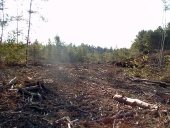posted 8 years ago
Hello all,
I'm hoping to get some humble opinions on a venture (Adventure) regarding a parcel of land that is separate from my home lot.
I'm trying not to be to long winded!
So here are the details:
I have a 2.25 acre parcel that is not attached to my main property and not part of my mortgage. The bank wouldn't touch it,
Because it is essentially landlocked. It sits behind my 2 acre home lot with a state owned public trail separating the two lots.
Long story short, I found a documented legal right of way to access the lot, and had a lawyer verify it. So no matter what the state does to the trail, I should always have access to the parcel.
Because it's landlocked, and road inaccessible, taxes are really affordable. So I bought it cash from the owner of the house on a separate deed.
It's mostly highland with a gentle southern slope. Along the southern edge of the property is a long field. It is a clearing maintained by a pipeline company. It's mostly grass and poison ivy.
The rest of it is mostly pine trees. There is some old foundation pieces from an old barn. Under the trees is just pine needles. Very little grass and other plants. There are a few deciduous trees sprinkled about. The barn foundation used to be a bottle pit and scrap metal pile which I already cleaned out.
So my initial plan was to slowly transform it from a stand of young pines into an apple orchard. I figured with a five year transformation plan and another 5-7 year grow plan, it'd be a nice orchard to keep me busy into retirement. Have friends and family over to pick apples, sell at the town farmer's market, etc, etc.
So, I meticulously marked out an acre of the land for the orchard and additional areas of tree removal for exposure to light. I get the bonus of the pipeline clearing I just need to trim out for morning and evening sun.
So then I dug up random soil pieces and submitted a soil test.
That's where things started to go south...
Kept simple, the PH is low at 4.5 and the nutrients are generally lacking. Phosphorus is just OK, and calcium and potassium is very low.
Based on my desired use for the land, the University extension recommended starting with 10000 lbs of dolomitic limestone.
Now, if this was road accessible maybe that wouldn't be too bad. That's where it gets tough.
No motor vehicles are allowed on the trail. Granted, I could cross the trail from property to property and probably be OK, but if I start rutting up the trail, I'll be drawing attention that I don't want and making things more complicated.
Even if I get across the trail, there is the pipeline to contend with. The owner of the pipeline will allow up to 15,000 lbs per axle IF the pipeline is at least 4 ft deep. For some reason, that determination is up to the property owner. That involves a survey and if it's not 4 ft deep, you must build it up to 4 ft to allow for traffic of that weight. Small tractors and lawn mowers don't pose an issue, just large vehicles.
So OK, maybe an old Cub or even a two-wheel tractor could be used for certain activities. Well,
Then's there's the issue of the pine trees. I can't get a truck or large tractor back there to remove the trees and rip out stumps.
OK, I can cut the trees down, harvest the wood for building material, and chip the rest.
Doable, but then I'm drying a lot of wood. OK. I could make Warre boxes or chicken coops and fund my plans.
So this got me thinking. Given the soil condition and the abundance of pine, perhaps growing blueberry bushes is not only realistic, but also attainable within reason.
So here's my plan-
1. Drop large pine trees.
2. Harvest lumber.
3. Chip branches.
4. Grind down stumps.
5. Fertilize.
6. Cover crop for a year or two.
7. Inoculate remaining stumps or logs with mushroom spores (There are a few that thrive in softwood)
8. Plant High bush Blueberries. Use pine chips and remaining needles for mulch.
9. Stick a couple beehives back there as well. Or move my current ones.
So that's most of the details. I've tried to maintain readability but to the point.
What do you all think? I'd rather get all of the hard work over with while I'm younger, but I don't want to get into a project where doom is guaranteed.
Opinions are appreciated. Thanks!





















